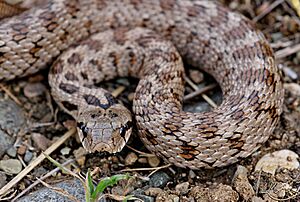Transcaucasian ratsnake facts for kids
Quick facts for kids Transcaucasian ratsnake |
|
|---|---|
 |
|
| Conservation status | |
| Scientific classification | |
| Genus: |
Zamenis
|
| Species: |
hohenackeri
|
| Synonyms | |
|
|
The Transcaucasian ratsnake (scientific name: Zamenis hohenackeri), also known as the Gavand snake, is a type of snake found in Western Asia and the Middle East. It belongs to a group of snakes called ratsnakes, which are part of the Colubridae family. This snake is completely non-venomous, meaning it is not harmful to humans.
Contents
Where Does the Transcaucasian Ratsnake Live?
The Transcaucasian ratsnake lives in many countries across Western Asia and the Middle East. You can find this snake in Armenia, Azerbaijan, Georgia, Iran, Iraq, Israel, Lebanon, southwestern Russia, Syria, and Turkey.
What Kind of Places Does it Like?
These snakes prefer to live in mountain areas. They can be found at different heights, from about 100 meters (330 feet) up to 3,000 meters (9,800 feet) above sea level. They are quite adaptable and can live in many different types of places, from dry lands to wetter areas, and even in agricultural areas (farms).
What Does the Transcaucasian Ratsnake Look Like?
The Transcaucasian ratsnake can grow to be about 65 centimeters (about 25 inches) long. This includes its tail, which can be around 11 centimeters (about 4 inches) long.
Colors and Patterns
On its back, this snake is usually gray. It has four rows of dark brown spots that go along its body. Its belly is reddish or yellowish and often has gray spots or patterns. On its head, you might see a black line that goes from its eye down to the corner of its mouth. There's also a short black line right below its eye.
Transcaucasian Ratsnake Behavior
The Transcaucasian ratsnake spends most of its time on the ground. It is also a diurnal animal, which means it is active during the daytime.
Reproduction and Life Cycle
The Transcaucasian ratsnake is an egg-laying snake. This means the mother snake lays eggs, and the baby snakes hatch from them. When a female snake lays eggs, she usually lays between 3 and 7 eggs at a time.
Different Types of Transcaucasian Ratsnakes
Scientists recognize three different types, or subspecies, of the Transcaucasian ratsnake. These are:
- Zamenis hohenackeri hohenackeri
- Zamenis hohenackeri lyciensis
- Zamenis hohenackeri tauricus


